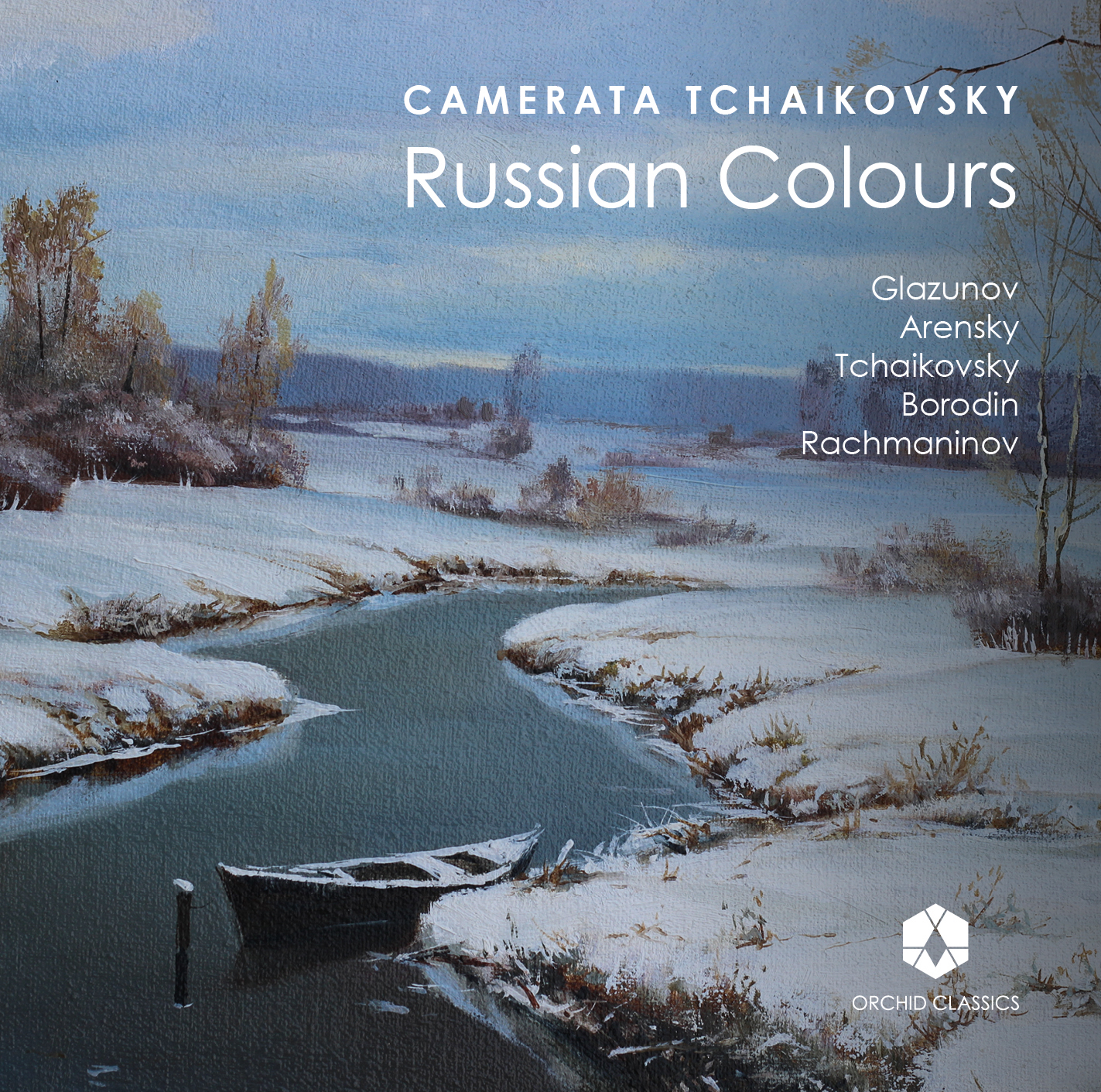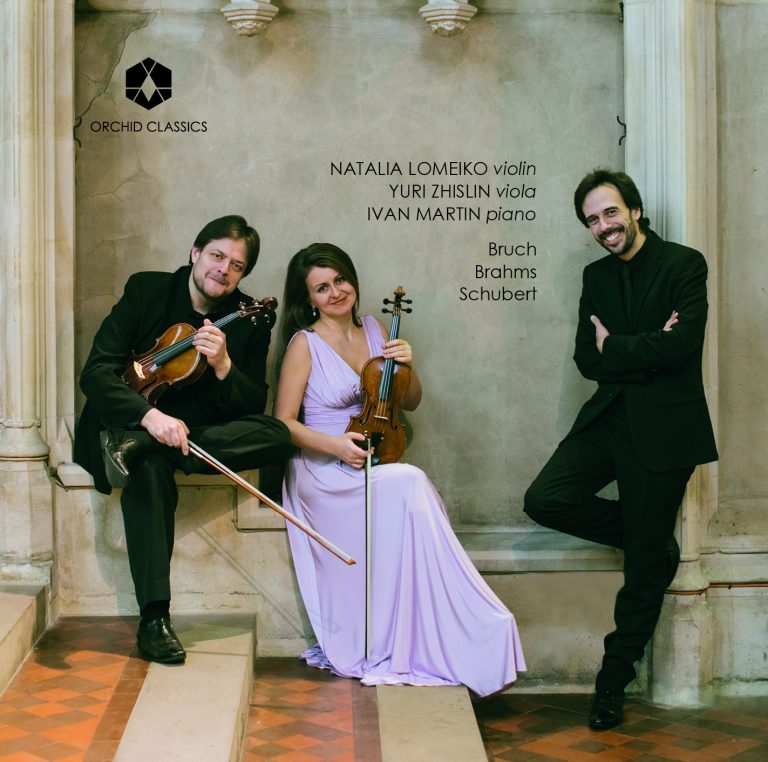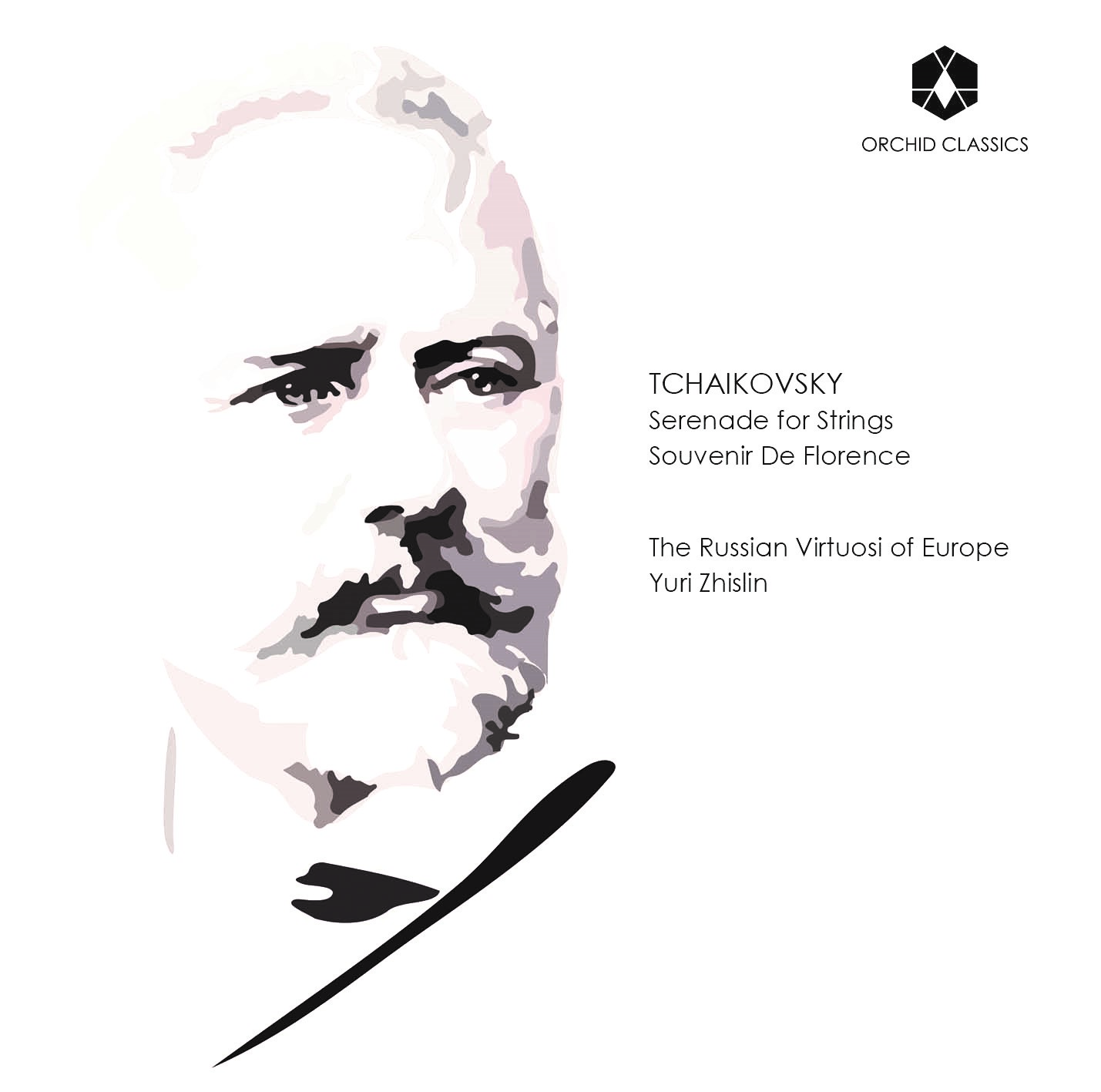Artist Led, Creatively Driven

Russian Colours
Camerata Tchaikovsky
Yuri Zhislin – viola / director
Release Date: 19th June 2020
ORC100136
Russian Colours
Camerata Tchaikovsky
Alexander Glazunov (1865–1936)
Concerto for alto saxophone and string orchestra in E flat, Op.109
Transcription for viola and string orchestra by Yuri Zhislin
1 Allegro moderato 4.16
2 Andante 3.34
3 Moderato – Cadenza 1.38
4 Allegro 5.02
Yuri Zhislin, viola
Anton Arensky (1861–1906)
String Quartet No.2 in A minor, Op.35a (1894)
First and third movements arranged for string orchestra by Yuri Zhislin
5 Moderato 11.28
6 Variations on a theme by Tchaikovsky – Moderato 13.20
7 Finale – Andante sostenuto 4.26
Pyotr Il’yich Tchaikovsky (1840–1893)
8 Andante cantabile from String Quartet No.1, Op.11 (1871) 6.12
Arranged for string orchestra by Yuri Zhislin
Alexander Borodin (1833–1887)
9 Nocturne from String Quartet No.2 (1881) 7.29
Arranged for string orchestra by Yuri Zhislin
Sergei Rachmaninov (1873–1943)
10 Vocalise, Op.34 (1912) 6.00
Arranged for string orchestra by Yuri Zhislin
Total Time 63.27
Yuri Zhislin, violin / director
We are delighted to present this album with some of the most romantic Russian works for strings.
Ever since I heard and played the Arensky Quartet, Op.35 in A minor for the first time many years ago, I have wanted to know what it would sound like arranged for a string orchestra.
The version on this recording is based on the composer’s own arrangement of the work, which was originally written for an unusual line up: violin, viola and two cellos. The first and last movements are my own arrangements, while the second movement – Variations on a Theme by Tchaikovsky – is the pre-existing version by the composer (Op.35a).
The Glazunov Concerto for Alto Saxophone and Strings is another beautiful, romantic work, which is less known to wider audiences than his much loved Violin Concerto. I hope that this version, which is my arrangement for viola and strings, will make a nice addition to the viola repertoire.
The wonderful Nocturne from Borodin’s String Quartet No.2 and Andante cantabile from Tchaikovsky’s String Quartet, Op.11 No.1, have both had a double bass line added to their scores, while the divine Vocalise by Rachmaninov has had a minor voicing makeover, to allow different instruments in the ensemble to shine through.
I hope you will enjoy the recording.
Yuri Zhislin, 2020
Alexander Borodin (1833-1887) was one of five Russian composers who came to be known collectively as the Moguchaya kuchka or ‘Mighty Handful’, sometimes also called the ‘Russian Five’, consisting of Balakirev, Rimsky-Korsakov, Cui, Mussorgsky and Borodin. Of these, Balakirev was the only one whose principal training had been musical. Borodin was the son of a Georgian prince and his mistress, and as such had been given a good education; he became a Doctor of Medicine, serving as an army medic (encountering the soldier Mussorgsky in the process), before embarking on a career as a research chemist specialising in aldehydes. Music was essentially a hobby, and although Borodin’s output reflects the preoccupations of the Mighty Handful in the adoption of folk styles, it also shows an interest in classical forms, such as chamber music, that were generally of less interest to his colleagues. Borodin usually composed slowly, but he wrote the String Quartet No.2 in a rapid flurry of activity during a summer holiday in July and August 1881. Dedicated to his wife, Ekaterina, to mark the 20th anniversary of their engagement, this was to be Borodin’s last major work; a few years later he died suddenly while dressed as a Russian peasant for a carnival party at the St Petersburg Medical-Surgical Academy.
Borodin did not ascribe a definite programme to his String Quartet No.2, but he did acknowledge that each movement was intended to evoke a specific scene or atmosphere. He conceived the famous third movement, the Notturno or Nocturne, as a love duet, and its charm has proven so irresistible that it has been rearranged in numerous guises, from a violin and piano version made by Rimsky-Korsakov, to the song, And This is My Beloved, adapted by Robert Wright and George Forrest for their Broadway musical Kismet in 1953. This string ensemble version was arranged by Yuri Zhislin. The movement opens with a fragrant melody over a gently pulsing accompaniment, with a secondary theme introduced at a slightly quicker pace. This theme is ornamented with decorative trills; an allusion to what Borodin and his peers would have recognised as the ‘Oriental’ style. The melodies overlap in their love duet, with canonic devices used to sustain momentum over an accompaniment of delicate effects including tremolando and pizzicato strings.
Pyotr Il’yich Tchaikovsky (1840-1893) felt a greater kinship with the Germanic tradition than with the Mighty Handful, and his music was frequently subjected to the stringent judgements of Balakirev. Tchaikovsky became used to rejection and criticism, with many of his scores vastly underestimated during his lifetime, but his string quartets were a notable exception, bringing him considerable acclaim when they were first written. Much of the quartet music has since been neglected, but the Andante cantabile from Tchaikovsky’s String Quartet No.1 has endured. When Tolstoy first heard this movement in 1876 he was deeply moved: “…Tolstoy, sitting next to me and listening to the Andante of my First Quartet, burst into tears…”
The full quartet was first performed in March 1871 by four members of the Russian Musical Society, and Tchaikovsky subsequently arranged the Andante cantabile for cello and string orchestra. The melody was inspired by a folk song heard by Tchaikovsky when he was visiting his sister’s house in Kamenka. At the start of the movement, Tchaikovsky slowly unfurls an elegiac melody. Sun breaks through the shadow with contrasting passages in a gently animated style, the supporting strings adding rhythmic impetus, but the main theme soon returns with renewed intensity, developing into passionate rhetorical gestures. As the music fades, we hear a series of brief statements before an ascending line leads to the final held note, and the work ends with exquisite serenity.
Sergei Rachmaninov (1873-1943) admired Tchaikovsky enormously. In 1889, at the age of 16, he was asked to prepare a piano duet transcription of Tchaikovsky’s ballet, The Sleeping Beauty. The older composer was dissatisfied with the result, but later became a devotee of Rachmaninov’s music. When Tchaikovsky died in 1893, Rachmaninov was devastated and his productivity suffered. The Vocalise, Op.34, No.14, is the last of Rachmaninov’s 14 Songs of 1912 and is dedicated to the soprano Antonina Nezhdanova. Unusually, the original song has no text; Rachmaninov was treating the voice like an instrument, with the vocalist allowed to choose a vowel sound through which to articulate the song’s beautiful, imploring melody. Inevitably, this has led to a number of instrumental versions for various combinations, including this arrangement by Yuri Zhislin.
Russian music in the second half of the 19th century generally fell into two overlapping but distinct groups: the Nationalists, represented by the Mighty Handful, and those who, like Tchaikovsky, felt greater kinship with the Germanic tradition. This presented the next generation of Russian composers with an interesting set of choices when it came to their own sense of lineage and direction. Like Rachmaninov, Anton Arensky (1861-1906) was an admirer of Tchaikovsky, even though his own teacher had been Rimsky-Korsakov, with whom he studied in St Petersburg. Rimsky-Korsakov did not approve of his student:
“According to all testimony, his life had run a dissipated course between wine and card-playing, yet his activity as a composer was most fertile… He did work much at composition but that is just where he began to burn the candle at both ends. Revels, card-playing, health undermined by this mode of living, galloping consumption as the final result, dying at Nice, and death at last in Finland… In his youth Arensky had not escaped entirely my own influence; later he fell under that of Tchaikovsky. He will soon be forgotten.”
Another member of the Mighty Handful, Balakirev, was less dismissive. Balakirev saw enough promise in Arensky to recommend that he become his successor as Director of the Imperial Chapel in St Petersburg. Arensky took up the position in 1894, the same year in which he produced his String Quartet No.2, Op.35, scored for violin, viola and two cellos, and dedicated to Tchaikovsky, who had died in the preceding year. The slow movement was greeted with great warmth following the quartet’s premiere, prompting Arensky to transcribe it for string orchestra as a piece entitled Variations on a Theme by Tchaikovsky, Op.35a. The piece, which has become Arensky’s most popular work, is based on the song ‘Legend’, the fifth of Tchaikovsky’s 16 Children’s Songs, Op.54. After the graceful theme is stated, Arensky treats it to a series of elegant variations, and although the pace shifts between quick and slow, the essential lyricism of the theme prevails.
In 1879, the young Alexander Glazunov (1865-1936) met Balakirev, who recommended he receive tuition from Rimsky-Korsakov. Glazunov was prodigiously talented and, according Rimsky-Korsakov, progressed “not from day to day but from hour to hour”. He set numerous musical precedents in Russian music, but had reservations about modernity; he was suspicious of Stravinsky’s use of dissonance, and of Debussy, he asked: “Could it be that Rimsky and I influenced the orchestration of all these contemporary degenerates?”
Yet Glazunov was charmed by the unusual and relatively modern timbre of the saxophone. In 1932, his health deteriorating, he settled in Paris, composing very little. Then in 1934 an irresistible commission came his way: German saxophonist Sigurd Raschèr pestered Glazunov for a concerto, and eventually the composer acquiesced, “under the influences of attacks rather than requests”. Glazunov’s Saxophone Concerto in E-flat major, Op.109 was finished in June 1934, and was published posthumously with an additional credit to the composer Petiot. Heard here with the viola taking the saxophone part, the work is in a single movement, beginning with a gentle introduction from the ensemble before the viola enters with a long-breathed, mellow melody. The music becomes increasingly animated and virtuosic, preceding a contemplative instrumental interlude. The viola sings a sustained tune, leading into its cadenza, and the work ends with fugal writing and a final flourish from the soloist.
© Joanna Wyld, 2020
Camerata Tchaikovsky
Yuri Zhislin, Founder and Music Director
The Camerata Tchaikovsky (formerly the Russian Virtuosi of Europe) chamber orchestra brings together some of the finest string players from across Europe.
Since their critically acclaimed Wigmore Hall debut in 2004, they have enjoyed performances across the UK (London’s Cadogan Hall, Kings Place and St John’s Smith Square), as well as Russia, Western Europe and South America, appearing in the legendary Moscow Conservatoire, Salle Gaveau in Paris, Stadtscasino in Basel, Teatro Coliseo in Buenos Aires and Teatro Solis in Montevideo.
The ensemble has been a regular visitor to the London Chamber Music Society Series at London’s Kings Place since 2011. They have collaborated with the renowned trumpeter Sergei Nakariakov, the British saxophone star Jess Gillam, the Swedish soprano Karin Dahlberg and the “father” of Russian Rock Boris Grebenshikov among many others.
The orchestra’s debut album on the Orchid Classics label was chosen “orchestral CD of the month” by the BBC Music Magazine in April 2016.
Future plans include a return tour to Russia, Western Europe and South America.
Yuri Zhislin
Described by the Strad Magazine as a “virtuoso with romantic temperament”, the London based Russian violinist and violist Yuri Zhislin is the 1993 BBC Radio Two Young Musician of the Year. He appeared as a soloist with the BBC Concert Orchestra, the London Mozart Players, the Oxford Philharmonic, the Moscow State Chamber orchestra, the Belgrade Philharmonic and the Santiago de Chile Symphony among others. Yuri’s performances and masterclasses have taken him to nearly 60 countries around the globe. He has recorded for Naxos, Orchid Classics and SOMM Recordings.
Yuri Zhislin is professor of violin and viola at the Royal College of Music.
“The three perennial (and exquisite) favourites that complete the collection enjoy beautifully nuanced performances.”
Gramophone Magazine
“…this is quality playing and programming, no doubt.”
BBC Music Magazine
“There is the same broad cantabile quality to the main melody, the same gentle yearning to its contrapuntal unwinding, even a similar pastoral quality to Glazunov’s dance-like-finale.”
The Strad
“This romantic programme aims at the heart but the musicians interpret the material with both passion and precision. Highly recommended.”
ArtMuseLondon
“…a highlight of a recording full of eminently listenable, assuredly repeatable, easily recommendable music and performances.”
Classics Today
“…the playing is consistently good with some beautifully expressive and sensitive music making.”
Music Web International
“Three perennial favourites complete a beautifully played and highly enjoyable CD.”
TheWholeNote
Translated:
“Camerata Tchaikovsky’s debut on Orchid was widely acclaimed….their playing is confident, tight, precise and engaging.”
Stretto Magazine









